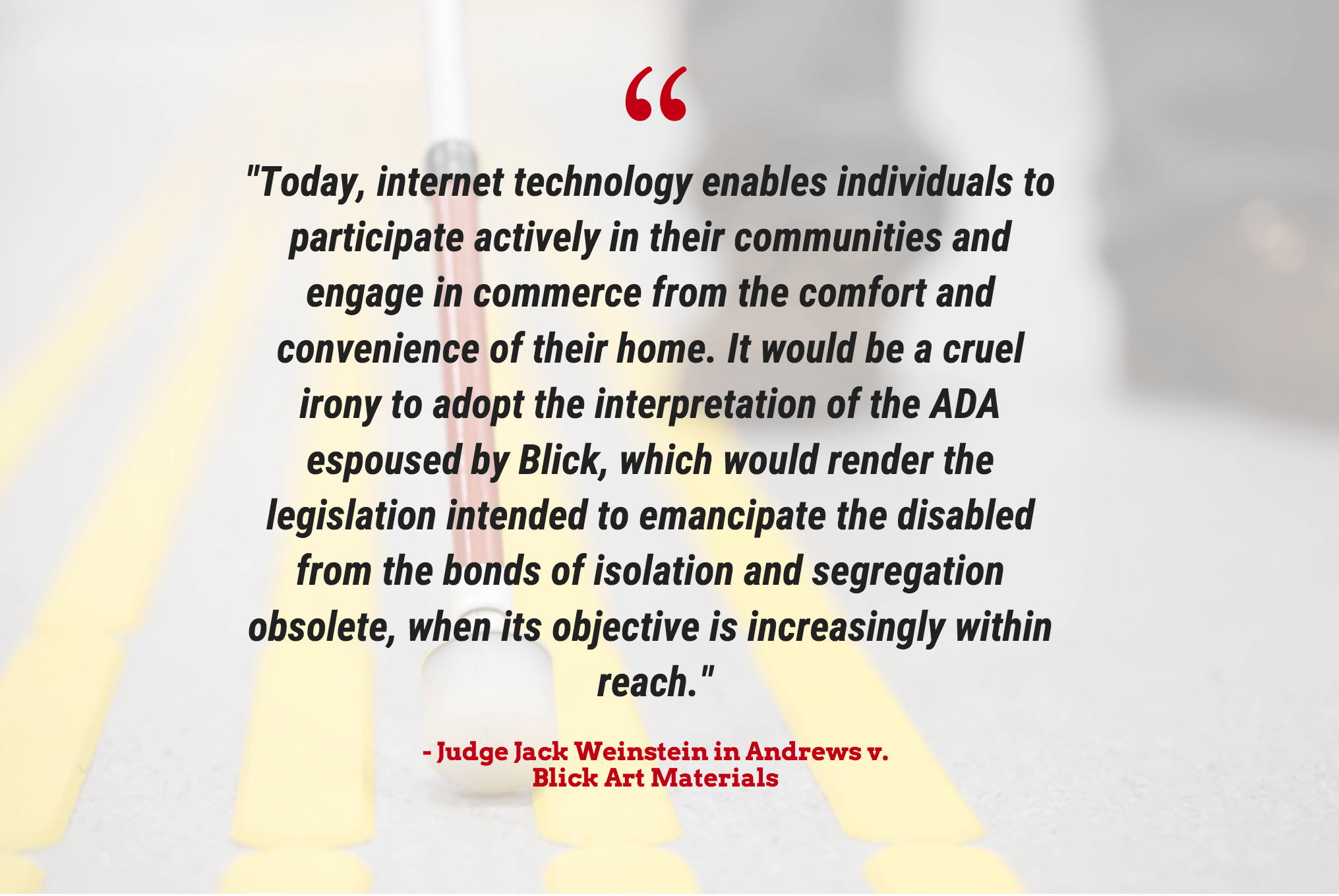Accessibility Laws for Public Websites
Updated: March 30, 2021
On July 26, 1990, the Americans with Disabilities Act (ADA) was passed. This broad anti-discrimination law requires the effective communication of information, and was enacted to protect individuals with disabilities from discrimination. Fast forward to the year 2017 and there is something very obvious missing from the ADA – any mention of digital or web accessibility. Although it’s hard to imagine life without the internet at our fingertips (let alone at all), the internet was not publicly available until August of 1991 – a year after the ADA was passed. The ADA’s vague language has lent itself to be applied to websites in several lawsuits, despite not being mentioned outright. Bobby Silverstein, who worked on the ADA for its chief sponsor, Senator Harkin, says Congress anticipated that the ADA would reflect the most current technology of a given time. They stated that the concept of discrimination “should keep pace with rapidly changing technology of the times.”
Title III of the ADA: An Overview
Title III of the ADA covers public accommodations, commercial facilities, and some private entities. Places of public accommodation include restaurants, hotels, theaters, shopping centers, doctors’ offices, museums, libraries, and many more. Under Title III of the ADA, public accommodations are required to provide auxiliary aids and services to ensure effective communication with individuals with disabilities.
The Judges Have Spoken: The ADA Applies to Web Accessibility
Over the last two decades – and increasingly in the last five years – courts have been ruling in support of web and video accessibility.
Winn-Dixie
Earlier this year, Florida grocery store chain, Winn-Dixie, found itself in a lawsuit for an allegedly inaccessible website. When their website was found to be inaccessible, the court was faced with the question of whether the website should be subject to the ADA as a service of a public accommodation. After dissecting each word, the Department of Justice (DOJ) determined that “discrimination applies to the provision of goods and services of a place of public accommodation, rather than just those goods and services at or in a place of public accommodation.” Federal District Court Judge Robert Scola determined that because of this, Winn-Dixie was in violation of Title III of the ADA.
This is a big win for web accessibility! The Winn-Dixie case is the first decision of its kind, where a public accommodation violated Title III of the ADA by having an inaccessible website. But wait – it gets even better! The Winn-Dixie case even goes so far as to recognize WCAG 2.0 as the standard for creating an accessible website. Although creating accessible content is often thought to be costly, in this case, the court determined that the $250,000 cost of making the website accessible was not considered “undue burden.” When they looked at the cost of launching Winn-Dixie’s website and redesigning it a year later, it was pocket change in comparison.
The Need for a Nexus
As showcased in the Winn-Dixie case, what falls under “place of public accommodation” is not always clear. In the Winn-Dixie case, Judge Scola made a powerful point, but in some other cases judges have decided a website must be closely connected to a physical place in order to be considered a place of public accommodation. For example, in the Winn-Dixie case the website is closely connected to the Winn-Dixie stores themselves because you can utilize the site to find store hours, locations, and download coupons to be used in-store.
This same issue of a connection to a physical place, or nexus, came up in the Target case back in 2006. The judge in NFB v. Target said that a website only has to be accessible if it has a connection to a physical place. Since Target’s website, like Winn-Dixie’s is strongly connected to physical Target stores their website would also need to be accessible under the ADA.
In another case – Andrews v. Blick Art Materials – two aspects of the website related to Blick’s physical retail stores include a “store locator” feature, as well as the option to purchase online for pickup at a store location. The judge in this case had a very strong feeling as to what the ADA was meant to do and how that relates to today’s digital world.
The Extension of “Places of Public Accommodations” to the Web
Despite some courts saying you need a close connection to a physical store, several judges found this completely irrelevant. They argued against the need for a nexus, because let’s face it, in todays world, the cyberspace is a place of its own. In these cases, judges have expanded the umbrella term “place of public accommodation” to include online places such as Netflix and Scribd.
Netflix
In 2010, the National Association of the Deaf (NAD) brought a suit against Netflix for discrimination for a lack of closed captioning on their streaming video. The NAD asserted that Netflix is a “place of public accommodation” (despite no brick and mortar location) and that they are covered under the ADA. Since the internet was not nearly as prominent as it is today when the ADA was published, it has been assumed for quite some time that the term “place of public accommodation” refers only to physical places.
The decision to move forward with this case was pretty significant, as it was the first time the ADA had been interpreted to apply to online-only businesses. In October of 2012 Netflix settled and agreed to caption 100% of their video content retroactively, and continue captioning new content moving forward.
Scribd
Similarly to the Netflix case, a federal court in Vermont determined that Scribd (another online-only business with no nexus) is considered a place of public accommodation and is subject to the rules and regulations of the ADA. In this particular case, the court explained:
Although it’s still not written into the ADA (and won’t be for some time) these cases show us that the term place of public accommodation can and does cover public websites regardless of a connection to a physical location or not.
Public Government Websites Are Covered by Section 508
While the ADA is a broad anti-discrimination law, The Rehabilitation Act, is a federal anti-discrimination law. This means it applies to federal and federally funded programs in their treatment of individuals with disabilities.
The Rehabilitation Act originally placed the most emphasis on equal employment practices,
reasonable accommodations, and federally subsidized programming for individuals with disabilities. Amendments to the act, however, have led to a more far-reaching interpretation of the law. That’s where Section 508 comes in! Section 508 is an amendment which expands the Rehabilitation Act to include equal access to electronic and information technology – a much needed addition with the arrival of the internet.
Section 508 requires that alternative, accessible information technology be provided to disabled individuals, and ensures accessibility to web content.
__
Not sure if your online content is accessible? Take this quiz to find out!








